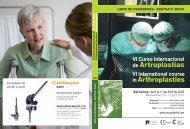cadera / hip - Active Congress.......
cadera / hip - Active Congress.......
cadera / hip - Active Congress.......
You also want an ePaper? Increase the reach of your titles
YUMPU automatically turns print PDFs into web optimized ePapers that Google loves.
MIÉRCOLES / WEDNESDAY<br />
118<br />
because of the thin polyethylene acetabular<br />
component. The large diameter metal heads<br />
coupled with polyethylene cups resulted in increased<br />
volumetric wear compared to 28mm<br />
diameter femoral heads articulating with<br />
polyethylene. The increased wear with subsequent<br />
osteolysis led to implant loosening.<br />
Since there was no centering femoral stem,<br />
unsatisfactory femoral positioning was more<br />
prevalent. The development of improved<br />
manufacturing methods and metal-on-metal<br />
articulations have provided an opportunity<br />
to once again explore resurfacing <strong>hip</strong> arthroplasty<br />
as a treatment approach to the younger<br />
arthritic patient. Metal-on-metal surfaces now<br />
are manufactured with tighter tolerances, better<br />
surface fi nishes and improved clearances<br />
that make it a useful articulation for SRA. A<br />
greater range of sizes with 2mm increments<br />
for better matching the patients anatomy<br />
has enhanced the opportunity for improved<br />
outcomes.<br />
Although the early results of these new<br />
designs of metal-on-metal surface replacements<br />
are generally excellent, a number<br />
of signifi cant problems still remain. These<br />
complications include: femoral neck fracture<br />
and femoral loosening, and the long-term issue<br />
of metal ion release from the surface of<br />
the metal-on-metal articulation. Early data<br />
focusing on the metal ion problem, indicate<br />
that there is a signifi cantly increased blood<br />
and tissue level of both cobalt and chromium,<br />
however, the clinical implications of these<br />
elevated metal ion levels has yet to be delineated.<br />
Patient selection still remains controversial.<br />
The ideal patient for a <strong>hip</strong> resurfacing<br />
procedure is usually a young, active patient<br />
with osteoarthritis without major deformities<br />
and excellent proximal femoral bone quality.<br />
Contraindications include elderly patients with<br />
poor femoral bone, metal hypersensitivity and<br />
impaired renal function. The role of surface<br />
replacement arthroplasty in inflammatory<br />
arthritis remains controversial. Large areas<br />
of avascular necrosis or large cysts in the<br />
femoral head may preclude the application<br />
of SRA.<br />
Our early experience with SRA of the <strong>hip</strong> is<br />
with the Conserve Plus Prosthesis® (Wright<br />
Medical Technologies), performed in seventy-eight<br />
consecutive patients. Seventy-eight<br />
replacements were performed and followed<br />
six to fi fty-two months (mean 30 months).<br />
The procedure was approved by the hospital<br />
institutional review board. The indications for<br />
the procedure included a younger age group<br />
with a high level of activity. All patients were<br />
Charnley Class A. All of the patients except<br />
one with avascular necrosis had a diagnosis<br />
of osteoarthritis. There were 57 males and<br />
21 females between the age of 29 and 65.<br />
The Conserve Plus® acetabular shell is<br />
170 degrees and nearly hemispherical. It is<br />
manufactured from a high carbon cast cobalt<br />
chromium molybdenum steel conforming to<br />
ASTM F75 standards. The exterior surface<br />
of the acetabular component has sintered<br />
beads ranging from 50-150 microns in diameter<br />
for cementless fi xation. The one piece<br />
acetabular shell is available in a 3.5mm<br />
thin shell and 5mm thick shell. The femoral<br />
component is greater then a hemisphere<br />
(208 degrees) which enables coverage of<br />
all the reamed bone by the component and<br />
maintains the length of the femoral head and<br />
neck. The surface fi nish is approximately<br />
0.008 micrometers. The component has<br />
a short metaphyseal stem and permits a<br />
cement mantle with an average thickness<br />
of 1.25mm around the femoral head. The<br />
components are available in 2mm increments<br />
(the acetabular sizes are 46 to 64 mm, the<br />
femoral head sizes 36 to 54 mm).<br />
The surgical technique has been previously<br />
described and uses a posterior approach. All<br />
patients were managed with adjusted lowdose<br />
Warafi n® for 3 weeks and prophylactic<br />
antibiotics (Kefzol®). Crutches with partial<br />
weight bearing were used for 6 weeks and<br />
a cane thereafter, until the patients did not<br />
have a signifi cant limp. Sports usually were<br />
permitted at four months post-operatively.





